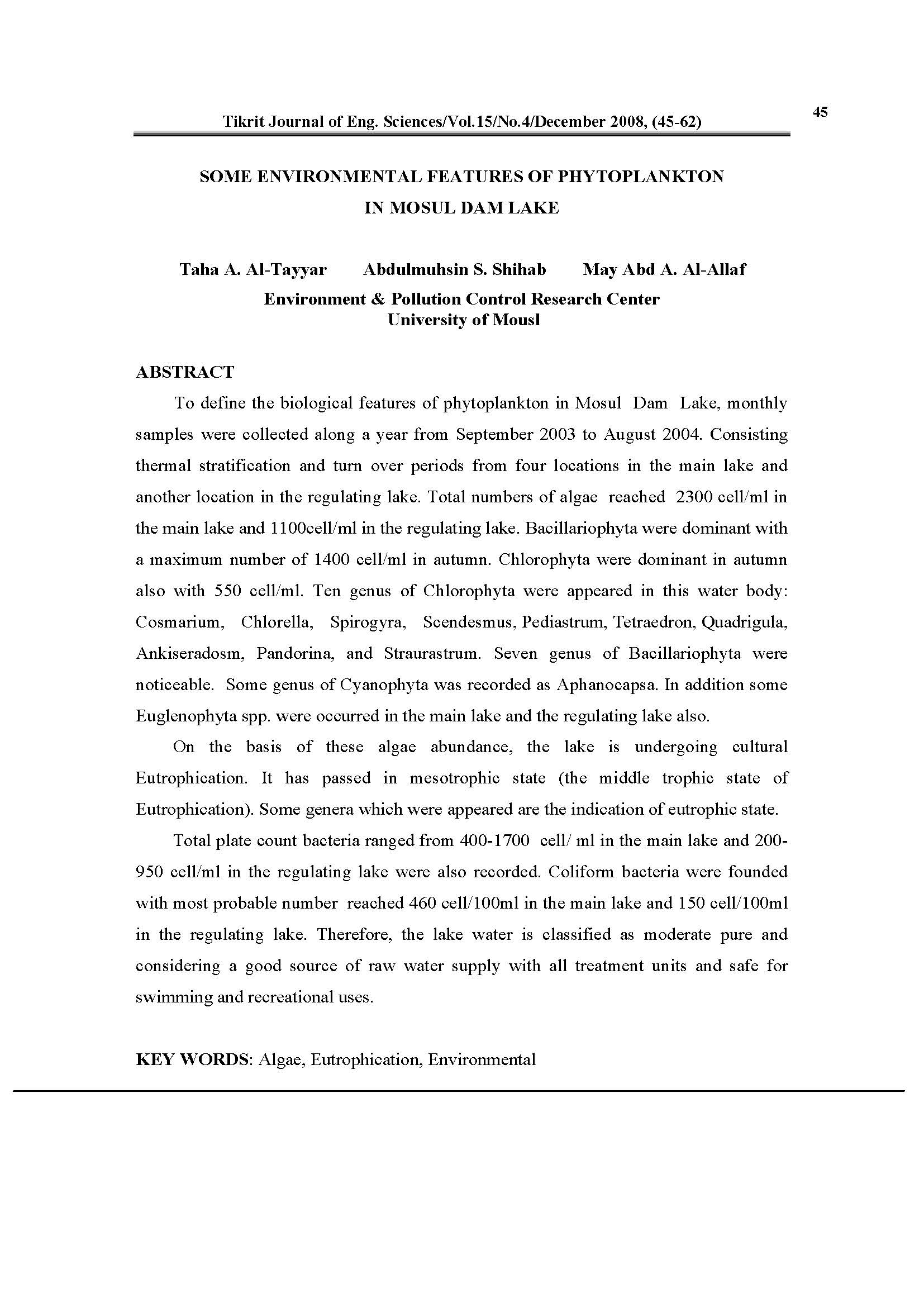Some Environmental Features of Phytoplankton in Mosul Dam Lake
Main Article Content
Abstract
To define the biological features of phytoplankton in Mosul Dam Lake, monthly samples were collected along a year from September 2003 to August 2004. Consisting thermal stratification and turn over periods from four locations in the main lake and another location in the regulating lake. Total numbers of algae reached 2300 cell/ml in the main lake and 1100cell/ml in the regulating lake. Bacillariophyta were dominant with a maximum number of 1400 cell/ml in autumn. Chlorophyta were dominant in autumn also with 550 cell/ml. Ten genus of Chlorophyta were appeared in this water body: Cosmarium, Chlorella, Spirogyra, Scendesmus, Pediastrum, Tetraedron, Quadrigula, Ankiseradosm, Pandorina, and Straurastrum. Seven genus of Bacillariophyta were noticeable. Some genus of Cyanophyta was recorded as Aphanocapsa. In addition some Euglenophyta spp. were occurred in the main lake and the regulating lake also. On the basis of these algae abundance, the lake is undergoing cultural Eutrophication. It has passed in mesotrophic state (the middle trophic state of Eutrophication). Some genera which were appeared are the indication of eutrophic state. Total plate count bacteria ranged from 400-1700 cell/ ml in the main lake and 200- 950 cell/ml in the regulating lake were also recorded. Coliform bacteria were founded with most probable number reached 460 cell/100ml in the main lake and 150 cell/100ml in the regulating lake. Therefore, the lake water is classified as moderate pure and considering a good source of raw water supply with all treatment units and safe for swimming and recreational uses.
Metrics
Article Details

This work is licensed under a Creative Commons Attribution 4.0 International License.
THIS IS AN OPEN ACCESS ARTICLE UNDER THE CC BY LICENSE http://creativecommons.org/licenses/by/4.0/
Plaudit
References
Sahin, B., “Epipelic and Epilithic Algae of the Yedigoller Lakes, Erzurum-Turkey” Turkish Jour of Biology, Vol.26, 221-226 pp. (2002).
Clare L. G. and Hopson N. E., “Algae Problems in Eastern Lake Erie” Jour. AWWA, Vol.67, No.3,131- 134 pp. (1975). DOI: https://doi.org/10.1002/j.1551-8833.1975.tb02175.x
Saha T., Roy A., and Ghosh P. B.,” Ecology of Bacterioplankton in a Nationally Important Lake, Rabindra Sarobar in Kolkata” Jour. Micro-Bio Biotechno Environmental Science, Vol.7, No. 4, 717-722 pp. (2005).
Ksoll W. B., Ishii S. and Hicks R., “Presence and Sources of Fecal Coliform Bacteria in Epilithic Periphton Communities of Lake Superior” Jour. Applied and Environmental Microbiology, Vol. 73, No. 12, 3771-3778 pp. June (2007). DOI: https://doi.org/10.1128/AEM.02654-06
Al-Tayyar T. A., “Effect of Saddam Dam Construction on Water Quality and Water Treatment Plants “M.Sc. thesis, College of engineering, University of Mosul, (1988).
Al-Mandel, F.A., “An Environmental -Limnological Study on The Regulating Lakes Phytoplankton of Mosul Dam” M.Sc. thesis, College of science, University of Mosul, (2005).
Al-Hassan F. Ibrahim, “The Increment of Algae in Tigris River due to The Impoundment and The Reflection on the Water Treatment Plants in Mosul” M.Sc. thesis, college of engineering, University of Mosul, (2001).
Al-Neema B., Nasory K., and Al- Dabbagh A., “Effect of Less Rainfull on The Quality of Tigris River Within Nineveh district” Jour. of Al-Rafidan Science,Vol.2, No. 2, 79- 93 pp. (2000).
AL-Taiee T. M., and Sulaiman Y. I., “Preliminary Water Balance of Saddam Dam Lake”, Proceeding of the Second Scientific Conference of SDRC, 121-134 pp.(1990).
AL-Obaydy F. Mahmmod, “Hydrological Study for The Stage and Discharge of Tigris River”, M.Sc. thesis, College of Engineering, University of Mosul, (1996).
Al-Layla M.A., and Al-Tayyar T.A., “Thermal Stratification in Large Water Body/Iraq” The Jordanian Conference on Civil Engineering, 2- 4 June, 847-858 pp. (1992).
Prescott G. W., “Algae of The Western Great Lakes Area” Revised Edition, WM. C. Brown Co. Publishers USA, 977 p. (1962). DOI: https://doi.org/10.5962/bhl.title.4650
Hinton G.F., and Maulood B.K., “Modified Method for The Enumeration of Either Marine or Freshwater Phytoplankton Concentrated on Membrane Filter ” Jour. Tropical Ecology, Vol. 20, No.2, 192-194 pp. (1979).
Goldman C. R., and Horne A. J., “Limnology” McGraw-Hill Book Company, Japan Ltd., 464 p. (1983).
Al-Singary M. Fathel, “Environmental Study on Tigris River in Mosul City” M.Sc. thesis, College of Science, University of Mosul, (2001).
Steidinger K. A., “Florida Harmful Algal Bloom Task Force: History and Focus” Proceedings of health effects of exposure to Cyanobacteria toxins: State of the science, August 13-14, USA., 6-15 pp. (2002).
Kumar S.S., and Ramakrishnan N., “Algae Diversity and Indicators of Pollution in Freshwater Pond at Tiruvannamalia” Jour. of Ecobiology, Vol. 16, No. 3, 207-212 pp. (2004).
McGauhey P. H., Engineering Management of Water Quality McGraw Hill Book Co., New York, 295 p. (1968).
Nathanson,J.A. and PE,Ms., Basic Environmental Technology, Water Supply, Waste Management, and Pollution Control Pearson Prentice Hall Co. Publishers, Fifth Edition, 534p.,(2008).
Ashesh T., and Chauhan S., ”Seasonal Phytoplanktonic Diversity of Kitham Lake Agra” Jour. of Environmental Biology, Vol. 27, No.1, 38-45 pp. (2006).





